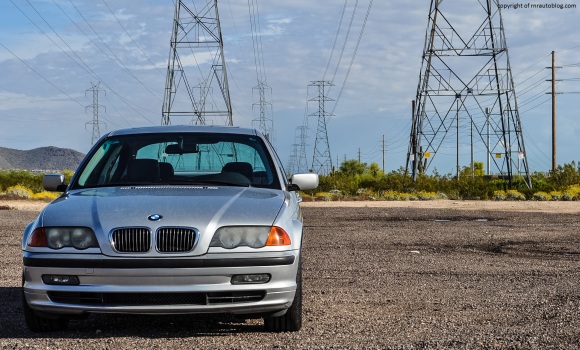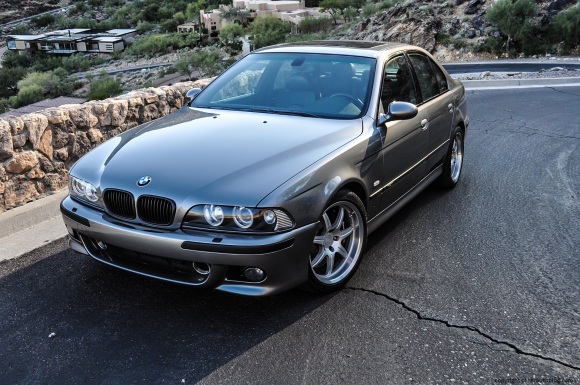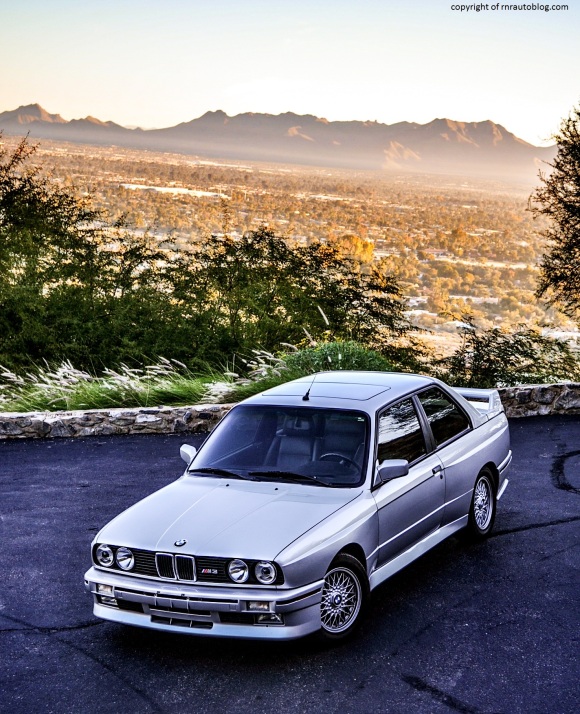Just from judging from the title of this review, you guys are probably thinking that I have an obsession with the 3-Series. That can be justified considering that I have reviewed a 1990 M3, 1994 325i, 2001 330i, 2009 328i, 2010 328i, 2011 335i, and a 2013 328i, and now I can add the 1999 328i to the mix. What makes this car so special? Well for starters, it is a manual transmission model of the coveted E46 generation. I say coveted because to this day, many car enthusiasts still regard the E46 generation (1999-2005) as one of the finest 3 Series ever produced. As with most nameplates, the 3-Series grew in size and comfort with every iteration, but this E46 represents a fine balance of what the 3 Series used to be: handling and poise in a right-sized package. Now for the traditional history lesson, the 3-Series debuted during the oil crisis. Replacing the 2002, the first 3 Series, the E21 (1975-1981) generation, was sold only in a two door format as a coupe or convertible. Known for its memorable driving dynamics and perky engines combined with its tidy size, the E21 cemented BMW’s reputation as a maker of ultimate driving machines. Five generations succeeded the E21, and with the exception of the latest 3-Series, the successive generations have all upheld the BMW tradition of providing excellent handling and performance in a luxurious package. The generation in review is the E46 which debuted in the United States in 1999. Whereas the previous generation (E36) didn’t deliver the driving experience as expected of a BMW (but it still drove quite well), this generation set a new performance benchmark for its class. This was the car that made other luxury brands take notice, and it is not hard to see why. In 2002, more than 560,000 units were sold worldwide, an impressive achievement for a luxury car. Even though I have already reviewed a 330i some time ago, I wanted to try out the less powerful variant, a 328i, especially with the manual transmission. Continue reading
RNR Automotive Blog
Just another car guy talking about cars.
Category Archives: BMW
2011 BMW 335i Review
You are probably confused and wondering why I am reviewing another E90 (2006-2011 generation) 3 Series if I have already reviewed both a 328i Sedan and a convertible. Well those were the 328i versions, and this is a 335i version. For those of you who know, my sister now drives the Pilot, and so I drive my father’s 2010 BMW 328i. One of my friends has a 2011 335i, and it is exactly the same color and the same generation as mine, so I thought, why not just do a review on his BMW? It may be another E90, but it is a 335i. The 335i is the top dog version with a turbocharged inline six cylinder engine whereas the lesser 328i versions make do with a normally aspirated inline six cylinder engine. The first 3 Series started with the E21 in 1975. At this time, BMW was cementing a reputation as a purveyor of “ultimate driving machines,” a strategy that culminated in the making of some very fine driving machines until recently. After the E21 came the 1982-1991 E30 which launched the first ever M3, then came the 1993-1998, then the 1999-2005 E46, then the 2006-2011 E90. Funny thing is that even as the BMW 3 Series slowly grew in size and status, it remained the undisputed compact luxury sedan in terms of prestige, sales, and driving enjoyment. No matter what other competitors threw at it, the BMW reigned supreme. After reviewing an E30 M3, E36 325i convertible, E46 330i, and two E90s, I can attest to that. I would not include the present generation F30 as one of the all time BMW driving greats because it is part of BMW’s new comfort oriented philosophy. The older the generation, the better driving characteristics they possess, but they are all fantastic to drive except the 2012-present F30 (which actually has started losing comparisons in automotive publications due to its worse handling). Since I drive a 328i, I was curious to see whether the twin turbocharged engine makes the 335i a better car than the 328i. Continue reading
2002 BMW M5 Dinan Edition Review
When I was little, I got my first car game to play on the computer, Need for Speed Hot Pursuit. Remember the Need For Speed series? How I miss the days of NFS Underground, Hot Pursuit, etc. In the Hot Pursuit game, one of the cars featured was an E39 M5 (BMW cars are classified by their generations so the 1996-2003 5 Series is the E39), and I became enamored with its power (in the game) and its styling. I never have and probably never will own a brand new luxury sedan, but if I had to go used, the only luxury sedans I would consider buying is the first generation Infiniti M or an E39 5 Series with a manual transmission. The first M vehicle for the 5 Series was the 1980 M535i although it was not badged as an actual M brand vehicle, but it came with performance and visual upgrades. The first actual M5 came with the second 5 Series generation (E28 1981-1988) in 1985-1988 which was only available with a manual transmission and sold in “Jet Black” color only. The next 5 Series generation (E34) brought along another M5 version that was sold from 1989-1995. The E28 and E34 were the last M5 models to be hand built before the E39 arrived. When the E39 M5 debuted in 1998, it took the world by storm. People raved about its 394 horsepower V8 engine, its butch looks, and its overall image as M’s flagship sports sedan. This M5 reviewed here is a Dinan edition; Dinan is a company that produces both mechanical and cosmetic aftermarket products for BMW vehicles. They also have a long standing relationship with BMW as Dinan modified BMWs are able to retain their factory warranties. Even though this is not the regular M5, I could not resist the opportunity to be able to review one of my favorite cars in the entire world. How desperate was I to review an E39 M5? So desperate that I saw this car in a parking lot and left a note on the windshield asking the owner if I can review the car. Fortunately the owner obliged. Continue reading
1990 BMW M3 Review
When I found out I would get the opportunity to review the first ever M3 ever produced, I was giddy with happiness and anxiety. Just to clarify how much of a coup this is, only 4,996 of these were sold in North America during its six year run. BMW’s M (called Motorsport GmbH then) was created in 1975 to aid BMW’s presence in motor racing in the 1960s-1970s. However, they started to add mechanical and cosmetic upgrades to BMW’s existing lineup to sell to the market. The first M-branded car launched was the 1979 M1, but BMW’s M division’s prominence did not emerge until they made an M version of the 5-series sedan, M535i, in 1979. The first actual separate M model debuted in 1985 for the M5, a version of the 5-Series. A M version of the E30 3-Series followed (BMW vehicles are classified by chassis numbers, so this generation is the E30) in 1986. Initially, the M3 was built to fulfill motor racing requirements. The World Touring Car Championship requires that the car be commercially produced in order for it to compete which is why the M3 was limited to just 5,000 units. However, the M3’s success was unprecedented, so production was expanded to almost 18,000 worldwide (including both convertible and coupe models). With the first M3 and M5, BMW and its M division cemented a reputation for itself in the automotive industry as a maker of the “ultimate driving machine” which was its slogan until recently. Sadly, as the luxury market has progressed in technology and power, BMW’s “M” cars have gotten a bit of an unflattering reputation. Once a division that pertained to strict principles of just manual transmissions, rear wheel drive, normally aspirated engines, the latest M cars are turbocharged, mostly automatics, and all wheel drive (at least for the SUVs and arriving soon for the M5). Not only that, and excuse my language, but the latest M cars have attracted a certain “douchebag” reputation. The general stereotype of the latest M cars is that they are driven by showoffs who could care less about the performance and handling capabilities and are focused on the cachet the M brand brings. However, this stereotype only pertains to the M cars manufactured around 5 years ago. This M3 reviewed here is the very first showcase of the M brand’s pure driving philosophy, and I was giddy with excitement as I got to review this gem. Continue reading
2013 BMW 328i Review
As you may know, for the past three years, I drove a Honda Pilot. But my sister drove a 2002 Toyota Camry LE, which got totaled this summer, so she got the Pilot. What I may not have mentioned is that since August, I have been driving a 2010 BMW 328i sedan (It’s my dad’s) . It was quite the change, as I actually have to worry about huge dips and speed bumps and what not. But I embraced the svelte inline six cylinder engine and the sublime handling. The 328i (I named her Gisele) is the last 3-Series they produced with the heavenly hydraulic steering. I know it seems trivial to obsess over a steering system, but that is what makes a BMW feel like a BMW. In other words, the steering is weighty and it is brimming with feedback. That is why when I got the opportunity to review the latest 3-Series, I approached this car with dread as it was going to be hard for me to remain objective. After all, I arrived to do the review in an E90 (3-Series’ are classified by their generation names. E90 is from 2006-2011, and F30 is 2012-present), review a F30, then leave in an E90. But what really made me approach the F30 with trepidation is the fact that the F30 replaces the amazing hydraulic steering system with an electric system. After reading reviews stating the obvious lack of feel in these new electric steering systems, I tried to approach this car with an open mind. I should explain: previous 3’s were not particularly fuel efficient, so BMW saw fit to install an a more fuel efficient electric system in the F30. The 3 series has a long history dating back to 1975 which when the first generation launched. Since the first generation, the 3 series has solidified its reputation as the best compact luxury sedan in the world. For five generations, it has remained supreme in terms of sales despite the emergence of worthy competitors. Now, it is going to be hard not to be biased. But I am going to try to be objective with the review of this car. It is just that I arrived in an E90 to test drive a F30, and I left in an E90. Can’t be that hard to remain objective right? I have reviewed the third, fourth, and fifth and I have loved them all, so hope was high that I would become fond of the sixth generation. Continue reading
2013 BMW X5 XDrive35i Review
Just like many other SUVs on sale today, the X5’s birth was a result of the SUV boom in the late 1990s. When BMW acquired Land Rover in 1994, it commenced development on their own SUV. BMW looked at the Land Rover Range Rover’s technology which was incorporated during the X5’s development. In fact, the first generation X5 utilized a split rear liftgate similar to the Range Rover’s as well as shared its technology and electronics. The rest of the X5 was taken from the 5 Series sedan. Unlike other SUVs which boasted their off road prowess, the X5 placed emphasis on its on road ability with claims of carlike handling and comfort. BMW dubbed the X5 as a Sport Activity Vehicle (SAV). Given that the SUV market was clamoring for luxury SUVs, the X5 was a runaway success when it launched in 1999. The X5 was praised for its sporty handling, quality interior, and its quick acceleration. It was also the first and last X5 to be available with a manual transmission. In 2006, BMW redesigned the X5, and unlike the first, this second generation utilized only BMW technologies. In BMW speak, the X5 underwent a “Life Cycle Impulse” (facelift) in 2011. Continue reading
1994 BMW 325i Convertible Review
Even though BMW is currently one of the world’s most profitable brands, that was not always the case. In 1959, BMW faced financial difficulties, and stockholders convened to decide whether to keep the company running or to go into liquidation. BMW was in such bad shape that rival Mercedes-Benz was considering buying out BMW just to wipe its competitor out. The stockholders agreed to keep carrying on. The success of economy cars in Europe convinced BMW to focus on small cars. BMW was formerly an aircraft engine manufacturer, and it used its engine expertise in developing the cars. The result of this was the BMW Isetta, which helped BMW get back on its feet. BMW wanted to move upmarket as to challenge Mercedes-Benz with the BMW 3 series. The third generation 3 series (E36) builds on the traits of the previous two 3’s with more power and comfort. Continue reading
2000 BMW Z3 Review
Contrary to what most people think, the Z3 was not the first Z to start off the Z series (Z3 and Z4). That title goes to the Z1. During 1989-1991, BMW built the Z1. The Z1 featured many innovative touches such as doors that slide down in their sills and a removable plastic body. This car could be driven with all of the body panels completely removed. They were never sold in North America, and the Z1 was discontinued after just two years and with 8,000 models produced. After noticing the success of the Mazda Miata roadster, BMW decided it wanted a piece of the action. Introduced in 1996, the Z3 made its debut in the James Bond film, Golden Eye, which BMW used to promote the car. The BMW Z3 emphasized its mix of modern BMW mechanicals with retro styling cues from the BMW 507 (a classic BMW roadster). It gained new interior and exterior revisions in 2000.
2009 BMW 328i Convertible Review
For the review of the sedan, click here.
Known for its success as a compact luxury sedan, the BMW 3 Series is BMW’s most important model. It combines dynamic excellence and typical BMW virtues into a small package. Adding to its appeal is its variety of body styles available. One of those body styles includes a convertible. The 3 Series convertible made its introduction in the E30 iteration in 1987. Fast forward to 2007 to the E90 iteration. The convertible body style always employed a traditional cloth top, but due to current trends, BMW ditched the traditional soft top for a metal hard top. This is surprising considering that the more expensive 6 Series convertible uses a cloth top. Nonetheless, the metal hardtop was a first for the 3 Series convertible.
2001 BMW 330i Review
Long touted as the best compact luxury car to drive, the BMW 3 Series was redesigned in 1999 (E46 generation). Succeeding the E36 generation (1990-2000), the BMW 3 Series made strides in comfort and refinement while honing its driving dynamics. How did I stumble upon this BMW? It all started with my friend. She got an “old” BMW, but did not know which it was. As a lover of old German cars, I jumped at the chance to review it. She said, “Okay, but it has to be really fast”. I then found out that the BMW was a 2001 330i, and the time frame was only 15 minutes. 15 minutes! And the car is not even washed. Can you really evaluate a car in 15 minutes? Only one way to find out.









